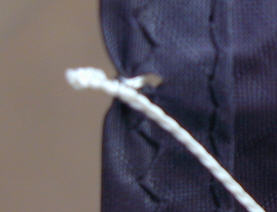Nasa ParaWing |
 |
|
Nasa ParaWing |
 |
|
|
|
| This is a rather easy but rather annoying part of NPW
building...
However bridling must be done precisely, as the inflight behaviour of this kite is strongly affected by bridling accuracy. |
Whatever bridling solution you choose (regular or cascade), the bridling
points are exactly the same.
|
 |
cascade bridling
|
This idea of this "new bridling" is not mine...It a Bill Painter's one. I am not sure that Bill was the first to "cascade bridle" a NPW, but he was for sure the first one who explained it on internet !!! Have a look to his site it worths the visit ! |
cascade bridling is composed of two stages of bridles :
|
 |
| Bridles measurements are provided into excel spreadsheet "calculations"
page cells C14 to C34
You can notice that most of bridles are "double". We can thus make bridling,
two bridles at a time (using the same cord for two bridles).
|
  |
cascade bridling tips
bridling is performed like this
|
 |
Fasten all secondary bridles
|
 |
Fasten all primary bridles
|
 |
handles and flying lines
|
 |
|
 |
|
 |
|
 |
your Nasa ParaWing is ready ... to fly !